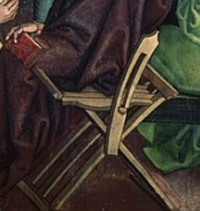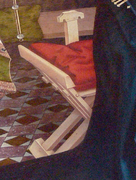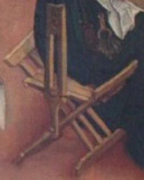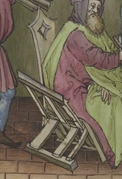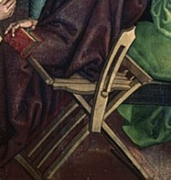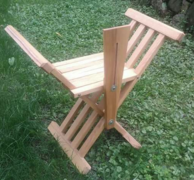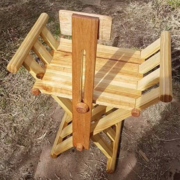Type 2B - Backed Stools
Background:
A clever if minor evolution of the scissor chair stool is the addition of a backboard. I have only found a couple of images of this type so far, all from the late 15th Century.
The structure is the same as for the Type 2A with the addition of a narrow vertical board to serve as back support. It is anchored to the center pivot of the legs and the center pivot of the seat. In order to preserve the ability to fold, the seat pin captured in a slot allowing it to ride up as the seat folds. Clever, not going to be super strong, but keeping in mind the stature of the typical medieval person, adequate for basic support.
Interestingly, all of the images of this style of stool that I have found so far depict a seat with only 3 legs per side. Though some of the illustrations are more artistic than others, the one of St. Jakob (in the appendix) has clear and believable details.
Seating:
Seating is along the X.
Practical Matters:
The one is clearly not much different than the Type 2A. The addition of the back doesn’t affect its ability to fold. The height of the back is probably governed by the height of the seat boards in the folded position as you wouldn’t what the single board to stick up and snag stuff.
Construction Notes:
I have recently completed one of these (shown to the right) for KASF 2020. Obviously, this isn't a lot different than the 2A stools. But for this version, I scaled up the dimensions. I wanted a stool that was...Ducal Class, not effete 15th Century Frenchman size.
I set the seat height to 20", for reference, the modern standard is 19". This is pretty comfortable for me, however, Eydis's feet don't touch the ground. This was done by changing the side of the primary rectangle from 7" to 10" (see the 2A construction notes for how this works).
For the back, I used a long piece of hickory that was on the dark side and went well with the red oak of the chair. This wood should resist vertical splitting from any stress on that center slot. The center pin has a rosewood end that locks the backboard into its slot. I am dubious about the long term durability of this arrangement. It simply can't take the stress of a serious lounging but it will help you through those longer courts with some back support.
Common Terms: I haven't seen this type of chair specifically referenced in any text yet.
Gallery of Period Illustrations and Extant Examples
Gallery of Modern Reproductions
Folding Chairs Home
| Type 1 | Type 1A | Type 1B | Type 2 | Type 2A | Type 2B | Type 2C | Type 2D | Type 2E | Type 3 |
